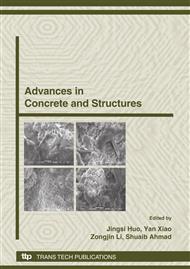p.575
p.581
p.587
p.593
p.599
p.607
p.613
p.621
p.627
Study on Evaluation Method of High-Rise Building Performance by Equivalent Single Degree of Freedom System
Abstract:
A performance evaluation method of high-rise buildings is presented, by means of capacity spectra method which allows for higher mode effects. The multi-degree-of-freedom system (MDOF) of each mode is transformed into equivalent single-degree-of-freedom (ESDOF) system, and the ESDOF system is supposed to be elastic perfectly plastic. In elastic range, the equivalent displacement of ESDOF system for each mode is deduced by displacement response spectra based on the natural period, and the structural lateral elastic displacement of each mode could be determined by the corresponding equivalent displacement and mode shape. In inelastic range, according to capacity spectra method, the relationships among demand curve, capacity curve and ductility coefficient are built. The structural performance under moderate or major earthquake is determined by iteration method. The paper illustrates the application of the proposed procedure with an example and attempts to prove its feasibility by nonlinear time-history analysis.
Info:
Periodical:
Pages:
599-605
Citation:
Online since:
October 2008
Authors:
Price:
Сopyright:
© 2009 Trans Tech Publications Ltd. All Rights Reserved
Share:
Citation:


